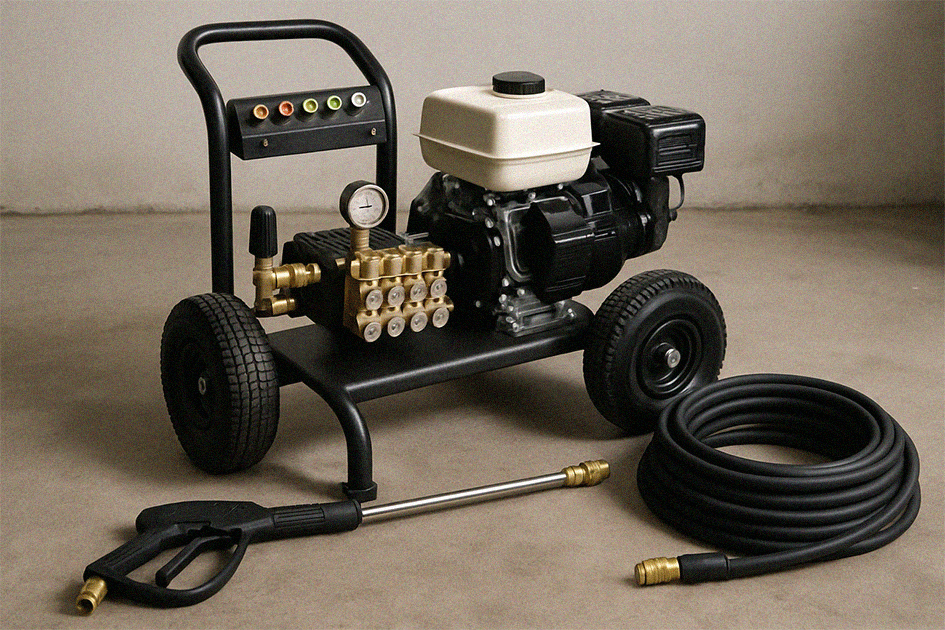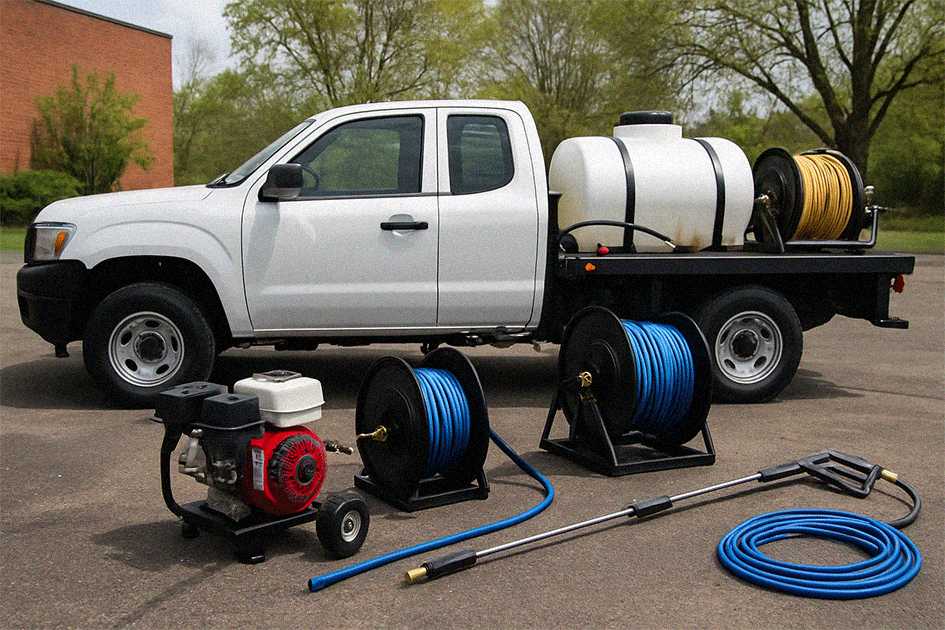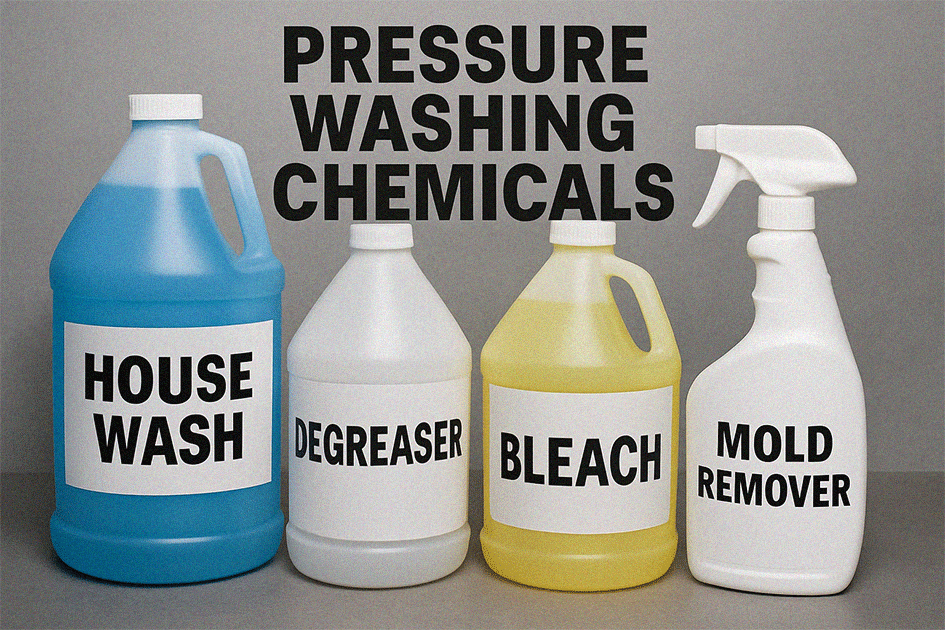
Pressure washers are powerful tools that can transform your property—but they're also potentially dangerous when used improperly. Every year, thousands of people are injured in pressure washing accidents, many of which could have been prevented with proper knowledge and precautions. Whether you're considering DIY pressure washing or hiring professionals, understanding safety is essential for protecting yourself, your family, and your property.
The Hidden Dangers of Pressure Washing
The deceptively simple appearance of pressure washers masks genuine danger. Commercial units can exceed 4,000 PSI (pounds per square inch), propelling water at velocities over 200 mph—speeds comparable to some race cars. This generates enough force to cut through skin, shatter glass, or cause severe injuries that require immediate emergency medical attention. The combination of extreme pressure, high velocity, and often-awkward working positions creates hazards that many DIYers dramatically underestimate until they or someone nearby gets hurt.

Common Pressure Washing Injuries
Injection Injuries: The Most Dangerous
Injection injuries represent the most serious and frequently overlooked pressure washing hazard. The high-pressure water stream can penetrate skin and inject water, air, and debris deep into body tissues—an injury far more severe than it initially appears. What looks like a small puncture wound externally may conceal extensive internal damage to muscles, tendons, nerves, and blood vessels. These injuries require immediate emergency medical attention even if the wound appears minor, often necessitate surgery to clean contaminated tissue and prevent infection, and can lead to permanent disability or even amputation if treatment is delayed.
Injection injuries most commonly affect hands and feet, frequently occurring when someone tests spray pressure by hand (never do this), works too close to the spray, or experiences equipment malfunction. The critical danger is that victims often underestimate severity based on the small external wound, delaying medical care while internal damage worsens. If you suspect an injection injury, seek emergency treatment immediately—time is critical, and every hour of delay worsens outcomes.
Lacerations and Physical Injuries
High-pressure water cuts skin like a knife when directed at close range. Deep lacerations requiring stitches occur when spray contacts the body at insufficient distance, commonly affecting hands, arms, and legs during awkward positioning. These injuries happen in split seconds—faster than reflexes can pull away—making prevention through proper technique essential.
Eye injuries from flying debris or misdirected spray cause corneal abrasions, chemical injuries from cleaning solutions, temporary or permanent vision damage, and foreign object lodgment requiring medical removal. Slip and fall accidents on wet surfaces created during cleaning lead to injuries from slippery walkways and decks, falls from ladders or heights, trips over equipment or hoses, resulting in broken bones, head injuries, or worse.
Electrical hazards create life-threatening situations when water and electricity interact. Electric shock from faulty equipment, electrocution from spray hitting power lines, shock from wet electrical outlets, and lightning danger during storms all present real risks that proper precautions must address.
| Injury Type | Severity | Most Common Victims | Typical Cause | Prevention |
|---|---|---|---|---|
| Injection Injury | Critical | Hands, feet | Testing spray, close work | Never test by hand, maintain distance |
| Lacerations | Serious | Hands, arms, legs | Spray too close | Proper technique, safe distance |
| Eye Injury | Serious | Eyes | Flying debris, splash | Safety goggles, face shield |
| Falls | Moderate-Severe | Entire body | Wet surfaces, ladders | Non-slip footwear, avoid ladders |
| Electrical Shock | Critical-Fatal | Entire body | Water near electricity | GFCI outlets, avoid power lines |
Essential Safety Equipment
Operating pressure washers without proper protective equipment invites injury. Eye protection is absolutely non-negotiable—ANSI-approved safety glasses provide minimum protection, while full face shields are essential for overhead work, protecting from flying debris and preventing chemical splash injuries.
Protective clothing creates crucial barriers between you and hazards. Heavy-duty work pants—never shorts—combined with long-sleeve shirts or jackets protect from spray bounce-back that occurs constantly during operation. Closed-toe boots with steel toes (preferred) and non-slip soles prevent crushing injuries and maintain traction on wet surfaces. Never operate pressure washers in sandals or barefoot—this is asking for severe foot injuries. Heavy-duty work gloves protect hands from chemicals and abrasion while providing better equipment grip.
Hearing protection prevents long-term damage from pressure washers operating at 85+ decibels. Earplugs or earmuffs should be worn throughout operation to prevent cumulative hearing loss that DIYers often don't notice until it's irreversible.

Safe Operating Procedures
Safety begins before you pull the trigger and continues through every moment of operation and proper shutdown.
Critical Pre-Operation Steps
Read the manual thoroughly—not just skimming, but actually understanding your specific equipment, knowing pressure settings and their appropriate applications, learning safety features and emergency shutoffs, and following manufacturer guidelines precisely. Manuals exist because people get hurt without them.
Inspect equipment completely before each use. Check hoses for cracks, wear, or leaks that could cause sudden failures. Ensure all connections are secure—loose connections can whip violently when pressurized. Test safety features to verify they function properly. Verify proper oil and fuel levels to prevent mechanical failure during operation.
Clear the area of all people and pets—never allow anyone near active pressure washing. Secure loose objects that could become dangerous projectiles. Check for hidden hazards like wasp nests, unstable surfaces, or buried utilities. Identify power lines and electrical equipment, maintaining safe distances throughout work.
Test spray pattern on an inconspicuous area using the widest spray pattern initially, then adjust pressure as needed for the surface. Never test spray with your hand—this causes injection injuries. Use a test surface, observe the results, and adjust accordingly.
During Operation Safety
Proper grip and stance prevent loss of control. Maintain a two-handed grip on the wand at all times—pressure washer recoil can wrench equipment from single-handed grips. Keep a stable, balanced stance with firm footing on dry surfaces when possible, ready for spray recoil that can throw you off balance unexpectedly.
Spray technique follows specific safety rules. Keep the nozzle moving constantly—stationary spray can cut through materials. Maintain safe distance of 12-18 inches typically, adjusting based on surface type. Never point at people, pets, or yourself regardless of whether equipment is running. Work from bottom to top on vertical surfaces to prevent dirty water streaking clean areas.
Ladder safety deserves special attention because pressure washer recoil on ladders creates extreme fall risk. Use proper ladders designed for pressure washing work, have someone stabilize the ladder base, never lean or overreach which shifts your center of gravity, and strongly consider professional service for any work at heights—this is where most serious injuries occur.
Electrical safety prevents fatal accidents. Keep electrical cords dry at all times. Use GFCI-protected outlets that will trip if current leakage occurs. Stay clear of power lines maintaining at least 10 feet of distance. Turn off power to outdoor fixtures before cleaning nearby. Never spray electrical components, outlets, or equipment directly.
Chemical Safety Protocols
Cleaning solutions add chemical hazards to physical dangers. Read all product labels completely, understanding chemical hazards and toxicity, knowing proper dilution ratios precisely, learning first aid measures for exposure, and following mixing instructions exactly—approximations can create dangerous solutions.
Never mix chemicals under any circumstances. Never mix bleach and ammonia which creates toxic chlorine gas that can kill. Don't combine different cleaners which may create unpredictable reactions. Use one product at a time, rinsing thoroughly between different products. This rule has no exceptions—chemical mixing kills people every year.
Protect yourself during chemical application with chemical-resistant gloves rather than regular work gloves, eye protection preventing splash injuries, ventilation avoiding vapor inhalation, and work in well-ventilated areas preferably outdoors with good air movement.
Protect your property by covering plants and landscaping with tarps or plastic sheeting, rinsing vegetation immediately if accidentally contacted by chemicals, diverting runoff from storm drains that flow directly to waterways, and following all environmental guidelines for your area.
When to Call a Professional Instead
Many situations exceed safe DIY capabilities regardless of equipment or determination. High-risk situations include working above the first floor where falls cause severe injuries, proximity to power lines or electrical equipment, fragile or old materials that may fail unexpectedly, and removal of hazardous substances requiring specialized training.
Call professionals when you lack experience—first-time pressure washing carries high injury risk, unfamiliarity with equipment creates dangerous situations, uncertainty about pressure settings damages property or causes injury, and unknown proper techniques lead to mistakes with permanent consequences.
Physical limitations make some people inappropriate pressure washer operators. Balance or mobility issues increase fall risk dramatically. Inability to safely operate heavy equipment creates control problems. Difficulty handling equipment weight leads to fatigue and mistakes. Health conditions that increase risk should be respected rather than challenged.

| Situation | DIY Risk Level | Professional Recommended? | Primary Hazards |
|---|---|---|---|
| Single-story exterior, ground level | Moderate | Optional | Injection injury, lacerations, chemical exposure |
| Second story or higher | High | Strongly recommended | Falls from heights, ladder accidents |
| Near power lines | Critical | Yes - required | Electrocution, death |
| Delicate/old surfaces | Moderate-High | Recommended | Flying debris, structural failure |
| First-time user | High | Recommended | All hazards - lack experience to recognize dangers |
| Physical limitations | High-Critical | Required | Falls, loss of control, inability to respond to hazards |
Advantages of Professional Pressure Washing
Professional safety standards include extensively trained technicians who know proper techniques, have experience with various surfaces and conditions, and recognize and avoid hazards before incidents occur. They use commercial-grade, regularly maintained equipment with multiple pressure settings, comprehensive safety features and controls, and specialized tools for different situations.
Insurance coverage provides liability protection for property damage, worker's compensation covering their employees, property damage protection for your home, and peace of mind for homeowners who bear no liability for professional work.
Reduced risk eliminates your personal injury exposure—professionals handle all hazards while you avoid dangerous situations entirely. No ladder work for you, no exposure to chemicals, no equipment operation risks. Property damage risk vanishes through professional experience preventing damage, insurance covering any accidents, proper techniques protecting surfaces, and guaranteed results without your liability.
Emergency Response
If injuries occur despite precautions, immediate appropriate response is critical. For injection injuries, seek emergency medical attention immediately without waiting for pain or swelling to develop. Tell medical staff explicitly that it's a high-pressure injection injury. Time is critical—every hour of delay worsens outcomes and increases risk of permanent damage or amputation.
For eye injuries, flush with clean water for 15 minutes continuously, seek medical attention even if pain subsides, avoid rubbing eyes which can worsen damage, and remove contact lenses if possible to prevent further irritation.
For electric shock, don't touch the person if still in contact with electricity as you'll become another victim. Shut off the power source if safe to do so. Call 911 immediately. Begin CPR if needed and you're trained—electrical shock can stop the heart.
The Bottom Line on Safety
Pressure washing can be done safely—but it requires respect for equipment, proper safety gear, careful technique, and constant awareness of dangers. Many homeowners find that the risks, time, and effort of DIY pressure washing make professional service the better, safer choice. Professional pressure washing eliminates your personal risk while delivering superior guaranteed results.
Ready for Safe, Professional Pressure Washing?
At Exterior Shine, safety is our top priority. Our trained, insured technicians have the experience, equipment, and expertise to clean your property safely and effectively—so you don't have to risk injury or damage to yourself or your property.
Contact us at (704) 980-9859 for your free quote. Let our professionals handle the risks while you enjoy the results. Your safety and satisfaction are guaranteed!

Scott Deviney
Co-Founder & Customer Relations
Scott handles all aspects of customer service and ensures that every client receives the personalized attention they deserve. With a background in business management and a genuine passion for helping people, he's built Exterior Shine's reputation for outstanding customer care.
